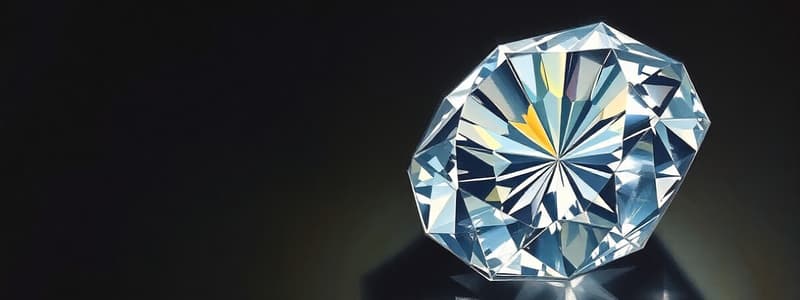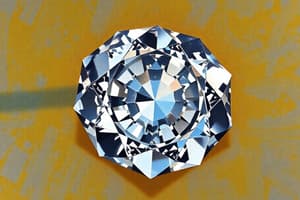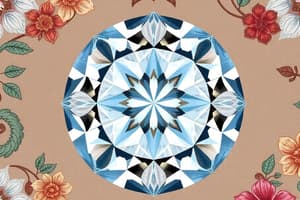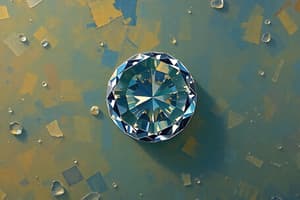Podcast
Questions and Answers
What does the 'VVS' grade indicate in diamonds?
What does the 'VVS' grade indicate in diamonds?
- Diamonds with minute inclusions that are difficult to see (correct)
- Diamonds with significant durability issues due to inclusions
- Diamonds that are completely free of inclusions
- Diamonds with visible inclusions under 10x magnification
Which type of diamond is likely to contain inclusions that can be seen face-up without magnification?
Which type of diamond is likely to contain inclusions that can be seen face-up without magnification?
- Slightly Included (SI)
- Included (I) (correct)
- Very Slightly Included (VS)
- Flawless (F)
How are Very Very Slightly Included diamonds graded?
How are Very Very Slightly Included diamonds graded?
- Based on the type and location of inclusions shown in a plot
- By the difficulty of seeing inclusions under 10x magnification (correct)
- By the overall visibility of inclusions under 10x magnification
- Based on their inclusions being easy to see without magnification
What type of inclusions might you typically find in a VS1 diamond?
What type of inclusions might you typically find in a VS1 diamond?
What does a clarity plot represent in diamond grading?
What does a clarity plot represent in diamond grading?
What is the primary difference between VVS1 and VVS2 diamonds?
What is the primary difference between VVS1 and VVS2 diamonds?
Which of the following best describes the inclusions in an I3 diamond?
Which of the following best describes the inclusions in an I3 diamond?
What distinguishes Slightly Included (SI) diamonds from Very Slightly Included (VS) diamonds?
What distinguishes Slightly Included (SI) diamonds from Very Slightly Included (VS) diamonds?
What is a common characteristic of inclusions found in SI1 diamonds?
What is a common characteristic of inclusions found in SI1 diamonds?
What does the green ink indicate when plotting clarity characteristics?
What does the green ink indicate when plotting clarity characteristics?
Where are characteristics that only break the surface plotted?
Where are characteristics that only break the surface plotted?
Which color ink indicates laser drill-holes among other characteristics?
Which color ink indicates laser drill-holes among other characteristics?
What is the best method for orienting a diamond to its clarity plot diagram?
What is the best method for orienting a diamond to its clarity plot diagram?
Which characteristics are typically plotted last on a clarity characteristics list?
Which characteristics are typically plotted last on a clarity characteristics list?
What tends to happen as the number of clarity characteristics decreases?
What tends to happen as the number of clarity characteristics decreases?
Which type of professionals most commonly plot diamond clarity characteristics?
Which type of professionals most commonly plot diamond clarity characteristics?
What is the purpose of plotting a natural characteristic on a clarity diagram?
What is the purpose of plotting a natural characteristic on a clarity diagram?
Which ink color is used to indicate extra facets when plotted?
Which ink color is used to indicate extra facets when plotted?
What characteristic is prioritized first when listing clarity features?
What characteristic is prioritized first when listing clarity features?
What is the primary factor that determines the clarity grade of a diamond?
What is the primary factor that determines the clarity grade of a diamond?
Which location of an inclusion typically has the greatest impact on a diamond's clarity grade?
Which location of an inclusion typically has the greatest impact on a diamond's clarity grade?
How does size influence a diamond's clarity grade?
How does size influence a diamond's clarity grade?
Which factor related to relief affects a diamond's clarity grading?
Which factor related to relief affects a diamond's clarity grading?
In the clarity grading procedure, what is the purpose of the wedge technique?
In the clarity grading procedure, what is the purpose of the wedge technique?
What does 'nature' refer to in the context of clarity grading?
What does 'nature' refer to in the context of clarity grading?
Which clarity factor is generally most visible and impactful for grading?
Which clarity factor is generally most visible and impactful for grading?
What is true about smaller inclusions regarding visibility?
What is true about smaller inclusions regarding visibility?
When establishing a clarity grade, which characteristic is typically given more weight?
When establishing a clarity grade, which characteristic is typically given more weight?
Which inclusion type often poses a greater risk to a diamond's integrity?
Which inclusion type often poses a greater risk to a diamond's integrity?
What defines a callable clarity characteristic in diamonds?
What defines a callable clarity characteristic in diamonds?
What is the primary consideration for assigning a clarity grade to a diamond?
What is the primary consideration for assigning a clarity grade to a diamond?
Which characteristic is NOT considered for a diamond to qualify as Flawless?
Which characteristic is NOT considered for a diamond to qualify as Flawless?
What clarity grade shows only insignificant blemishes but no inclusions?
What clarity grade shows only insignificant blemishes but no inclusions?
What is the significance of the clarity grade scale regarding inclusions and blemishes?
What is the significance of the clarity grade scale regarding inclusions and blemishes?
When were the IF and I3 grades added to the GIA grading system?
When were the IF and I3 grades added to the GIA grading system?
Which of the following statements is true regarding VVS diamonds?
Which of the following statements is true regarding VVS diamonds?
Which feature can allow a diamond to still be classified as Flawless?
Which feature can allow a diamond to still be classified as Flawless?
Which clarity characteristic is considered non-callable?
Which clarity characteristic is considered non-callable?
What was Richard T. Liddicoat's role in the GIA grading system?
What was Richard T. Liddicoat's role in the GIA grading system?
What characteristics are drawn only in green on a plot?
What characteristics are drawn only in green on a plot?
Flashcards
Very, Very Slightly Included (VVS)
Very, Very Slightly Included (VVS)
Diamonds with minute inclusions hard to see under 10x magnification. VVS1 inclusions are extremely hard to see, while VVS2 are very hard to see.
Very Slightly Included (VS)
Very Slightly Included (VS)
Diamonds with minor inclusions that are moderately visible under 10x magnification. VS1 harder to see, VS2 easier to see.
Slightly Included (SI)
Slightly Included (SI)
Diamonds with noticeable inclusions that are easy to see under 10x magnification. SI1 easier to see, SI2 much easier to see.
Included (I)
Included (I)
Signup and view all the flashcards
Clarity Grading
Clarity Grading
Signup and view all the flashcards
GIA Clarity Scale
GIA Clarity Scale
Signup and view all the flashcards
Inclusions
Inclusions
Signup and view all the flashcards
Clarity Plot
Clarity Plot
Signup and view all the flashcards
Diamond Clarity
Diamond Clarity
Signup and view all the flashcards
Surface Graining
Surface Graining
Signup and view all the flashcards
Callable Characteristic
Callable Characteristic
Signup and view all the flashcards
Non-callable Characteristic
Non-callable Characteristic
Signup and view all the flashcards
Flawless (F)
Flawless (F)
Signup and view all the flashcards
Internally Flawless (IF)
Internally Flawless (IF)
Signup and view all the flashcards
Blemishes
Blemishes
Signup and view all the flashcards
What does '10x magnification' refer to?
What does '10x magnification' refer to?
Signup and view all the flashcards
GIA Diamond Clarity Grading System
GIA Diamond Clarity Grading System
Signup and view all the flashcards
Clarity Factors
Clarity Factors
Signup and view all the flashcards
Clarity Characteristic Size
Clarity Characteristic Size
Signup and view all the flashcards
Clarity Characteristic Number
Clarity Characteristic Number
Signup and view all the flashcards
Clarity Characteristic Location
Clarity Characteristic Location
Signup and view all the flashcards
Clarity Characteristic Relief
Clarity Characteristic Relief
Signup and view all the flashcards
Clarity Characteristic Nature
Clarity Characteristic Nature
Signup and view all the flashcards
Wedge Technique
Wedge Technique
Signup and view all the flashcards
Diamond Pavilion View
Diamond Pavilion View
Signup and view all the flashcards
Increased Magnification
Increased Magnification
Signup and view all the flashcards
Green Ink
Green Ink
Signup and view all the flashcards
Red Ink
Red Ink
Signup and view all the flashcards
Black Ink
Black Ink
Signup and view all the flashcards
Crown Diagram
Crown Diagram
Signup and view all the flashcards
Pavilion Diagram
Pavilion Diagram
Signup and view all the flashcards
Surface-Breaking Characteristics
Surface-Breaking Characteristics
Signup and view all the flashcards
Diamond Plot Ordering
Diamond Plot Ordering
Signup and view all the flashcards
Identifying Features
Identifying Features
Signup and view all the flashcards
More Clarity Features, More Matching Difficulty
More Clarity Features, More Matching Difficulty
Signup and view all the flashcards
Study Notes
Diamond Grading Clarity
- GIA (Gemological Institute of America) introduced a diamond grading system in 1953
- Five clarity factors impact a diamond's grade: size, number, location (position), relief, and nature
- Size: Larger, more visible inclusions result in a lower clarity grade; size is relative to the diamond's size
- Number: More inclusions, or visible reflections, result in a lower clarity grade
- Facets act like mirrors, reflecting inclusions, making them more noticeable
- Grade is determined by visibility, not just the count of inclusions
- Location: Inclusions under the table are more visible; those near the girdle are less visible
- Relief: Contrast between an inclusion and host gem affects visibility
- Greater contrast makes the inclusion more apparent
- Differences in brightness, darkness, or color between inclusion and host gem impact visibility
- Nature: Refers to the characteristic's impact on the diamond; inclusions have more impact than blemishes
- Inclusions can pose a risk to the stone
- Clarity Grading Procedure
- Wedge Technique: Divides the stone into eight sections (wedges) for systematic search
- Pavilion view examined; facets and a portion of the girdle are examined
- Key characteristics are easier to identify and document with increased magnification
- Characteristics are callable (affect clarity) or non-callable (do not affect clarity), and are visible at 10x magnification
- 'Non-callable' inclusions are often called
+10x
- GIA Grade Scale
- Clarity descriptions of different grades vary
- Flawless (F): No inclusions or blemishes visible at 10x magnification; extra facets or internal graining may not be visible
- Internally Flawless (IF): Only insignificant blemishes, visible at 10x
- Very Very Slightly Included (VVS1 & VVS2): Minute inclusions, difficult to see
- Very Slightly Included (VS1 & VS2): Minor inclusions, ranging from difficult to somewhat easy to see
- Slightly Included (SL1 & SL2): Noticeable inclusions, easy/very easy to see at 10x
- Included (I1, I2, I3): Obvious inclusions at 10x; inclusions visible to the unaided eye. I3 inclusions might impact durability
- Plotting
- Graphical representation to map inclusions on a diamond
- Different colors/symbols for blemishes, inclusions
- Plots are created by appraisers, gemologists, or dealers
- Often, plots are for characteristics that significantly impact grade/condition
- Plotting is often for inclusions and features that are easy to locate or are significant
Studying That Suits You
Use AI to generate personalized quizzes and flashcards to suit your learning preferences.




